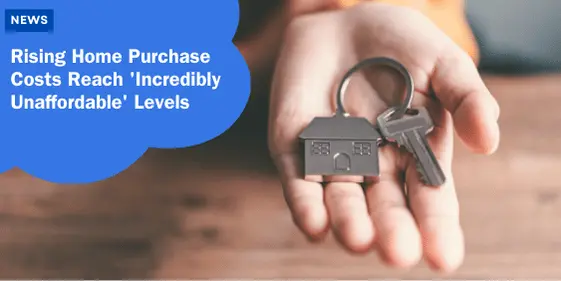Rising Home Purchase Costs Reach ‘Incredibly Unaffordable’ Levels

The Current Landscape of the Housing Market
In the dynamic world of real estate, prospective homebuyers are facing a dual reality: while there’s a slight reprieve in competition, soaring costs continue to make homeownership an increasingly unattainable dream for many.
This shift is due, in part, to rising interest rates that have cooled the previously white-hot housing market.
Bidding wars are less frequent, and homes may linger on the market for longer periods.
However, this doesn’t necessarily translate to affordability.
Home prices themselves remain stubbornly high, driven by ongoing supply chain issues and a continued shortage of available properties.
This creates a precarious situation for potential buyers.
While they may face less competition, the financial hurdle of securing a mortgage and affording monthly payments has become steeper.
Let’s delve deeper into the latest trends shaping the housing market and explore what they mean for both buyers and sellers in this ever-evolving landscape.
Homebuyer Index Insights
Recent data from the NBC News Home Buyer Index indicates a modest decline in homebuying difficulty, dropping to 82.2 in May.
This improvement is attributed to factors such as a boost in housing supply and a slowdown in buyer activity, offering a glimpse of hope amidst the affordability crisis gripping the nation.
However, affordability remains a daunting hurdle.
The Home Buyer Cost Index, which factors in home prices, mortgage rates, and insurance costs, has surged for the fourth consecutive month, hovering near record highs.
Daryl Fairweather, chief economist at Redfin, highlights the crux of the issue: “High prices combined with elevated mortgage rates make housing incredibly unaffordable for those dependent on financing their home purchase.”
Price Escalation and Affordability Challenges
Currently standing at approximately $444,000, this median price exceeds what an average household can comfortably afford by over $75,000, based on insights from NBC News’ analysis of Redfin data.
This disparity underscores the widening gap between housing costs and income levels across the country.
Improvements in Market Conditions
Despite these daunting statistics, there are glimmers of improving conditions.
Nationwide, competition among buyers has significantly decreased, marking its lowest point in more than a year.
This decline is reflected in the extended time homes spend on the market, now nearing pre-pandemic levels.
Moreover, the proportion of homes selling within two weeks has dropped to 36%, one of the lowest figures recorded in the past five years.
In May alone, the market saw a notable uptick with 1 million homes listed for sale, marking a 16% increase from the previous year.
While this surge in inventory offers hope for prospective buyers, it still lags 32% behind pre-pandemic levels observed in May 2019.
Notably, Florida emerges as a hotspot for inventory growth, with seven of its counties ranking among the top ten for inventory gains.
Regional Nuances: Florida’s Unique Scenario
Experts caution that not all inventory gains translate into favorable conditions for buyers, particularly in states like Florida.
The increase in housing supply in Florida is largely attributed to ongoing rebuilding efforts post-hurricanes, rather than a response to demand dynamics.
Lawrence Yun, chief economist at the National Association of Realtors, notes, “Despite the increase in inventory, homes are still selling swiftly in Florida, buoyed by robust job growth and population expansion.”
The Path Forward: Balancing Inventory and Demand
Looking ahead, Yun remains cautiously optimistic.
He points to the growing inventory across the nation, suggesting that homeowners are becoming less reluctant to sell.
This trend, according to Yun, signals a loosening of what he terms the “golden handcuffs” phenomenon, where homeowners were previously constrained by limited options and high demand.
“With each passing month, the grip of these ‘golden handcuffs’ weakens,” Yun remarks, hinting at potential shifts in market dynamics if inventory levels persistently rise.
He anticipates that sustained inventory growth could eventually lead to price adjustments, providing relief to buyers grappling with exorbitant housing costs.
Conclusion: Navigating the Evolving Real Estate Landscape
In conclusion, the current state of the housing market presents a complex interplay of challenges and opportunities for prospective homebuyers.
While there are indications of easing competition and modest increases in inventory, affordability remains a formidable barrier in many parts of the country.
Understanding these dynamics is crucial for stakeholders across the real estate spectrum, from policymakers to individual buyers.
As the market continues to evolve, addressing affordability concerns and promoting sustainable growth in housing supply will be key to fostering a more accessible and equitable housing market for all.






